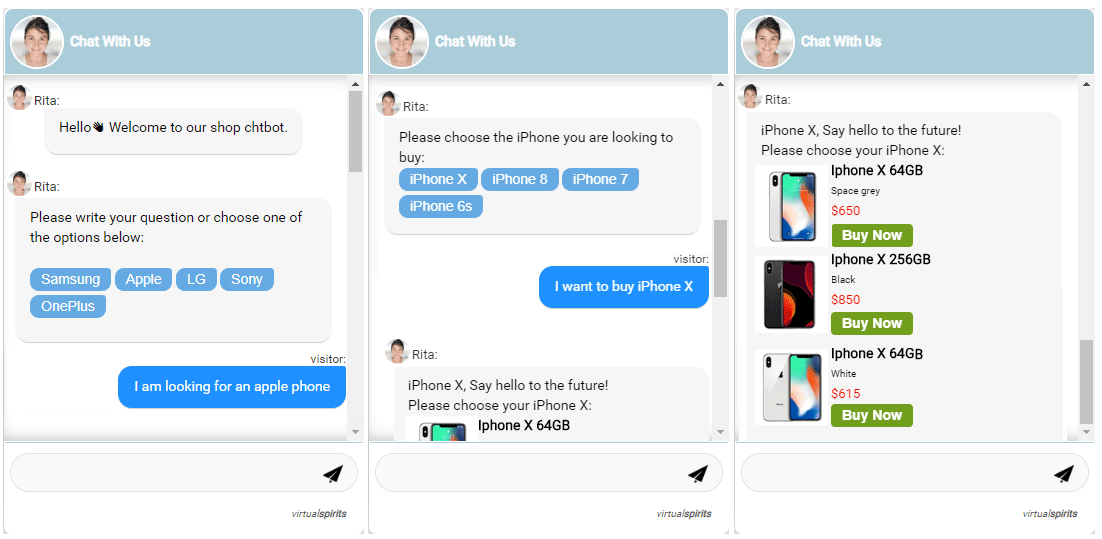
TOPICS:
Chatbot for Ecommerce Building a chatbot
Chatbot For Ecommerce – Overcoming Shopping Cart Abandonment Using Chatbots For Ecommerce
Chatbots for ecommerce help online stores overcome some key challenges that would otherwise lead to shopping cart abandonment. If you’re an ecommerce business owner, keep reading to find out how you can lower your cart abandonment numbers by choosing to create a chatbot.
It’s no secret that shopping cart abandonment is a problem for ecommerce businesses. But not everyone is aware of the magnitude of the problem. According to web usability research institute Baymard, a whopping
70% of online shopping carts don’t make it to checkout. Other studies back this finding, some even placing the percentage of abandoned shopping carts in the
early 80s.
These numbers represent a grim reality that applies to almost every ecommerce business in the world – that less than a third of its shoppers will actually end up buying something from the site. To reduce instances of shopping cart abandonment, ecommerce companies develop and implement a variety of strategies. The latest of these is also turning out to be the most effective to date. It involves building chatbots for ecommerce to incentivize purchases for customers.

Cart Abandonment Challenge #1: No one to talk to
Millennial online shoppers prefer websites that have chatbots for ecommerce on them. The mere presence of a chatbot goes a long way towards helping them trust the store and feel encouraged to check out its products. The best chatbots for ecommerce websites streamline the entire shopping experience for customers, helping them find and compare products, read buyer reviews, understand payment methods and shipping policies, and a lot more, without having to navigate the website or wait endlessly while a support rep fetches information for them.
These chatbots for ecommerce are particularly useful during the checkout stage. They can be sent out to offer additional information or assistance, or pitch limited-period discounts to encourage shoppers to proceed with their purchase. Without these AI bots holding their attention, shoppers can easily move on to other websites offering lower prices or more detailed product information.
The sections ahead will further illustrate some of the issues that chatbots for ecommerce can help customers with.
Cart Abandonment Challenge #2: Issues with shipping
High shipping costs are among the quickest ways to turn online shoppers away. Shoppers are often unaware of shipping costs until the checkout stage, at which point they realize they’ll have to pay extra to have their shipment delivered to them. Let’s look at what happens when Stephanie, who’s about to buy a handbag, gets to the checkout page and realizes that a shipping fee will be added to the total.
When Stephanie doesn’t click the payment button for a few minutes, the store’s online chatbot for ecommerce steps in.
Chatbot: “Hey there! You seem to have items in your cart. Is there something you need help with before completing your order?”
Stephanie: “There’s a $5 shipping fee added to my total, which wasn’t mentioned earlier.”
Chatbot: “This shipping fee is a flat fee charged by the seller of this particular product. We also have other shipping options that cost less. The table below has all the details (costs and delivery time frame).”
Stephanie: “Thanks. How do I change the shipping option on my order?”
Chatbot: “Which shipping option are you interested in?” [1/2/3]
Stephanie: [1]
Chatbot: “I’ve just edited your order to include shipping option [1], which costs $1. Your shipment will be delivered in 8-10 business days.”
By reducing the shipping costs for Stephanie, the chatbot increases her chances of going through with her purchase. The same result can be achieved by pitching a discount through a message like:
Chatbot: “Congratulations! Your order is eligible for FREE shipping. Check your cart to see your new order total.”
Cart Abandonment Challenge #3: Doubts about the product
Customers often have doubts about the product(s) they’ve added to their cart, which makes them hesitate just before checking out. These doubts could take multiple routes; a shopper could feel that a product is priced too high, while another might want to compare it with other products to make sure they’re making the right choice. Building chatbots for ecommerce can address all of these issues.
Let’s say that Chad has been browsing earphones on an online store. He’s seen multiple products and has finally added one to his cart.
Before he checks out, though, he stops to consider whether he’s making the right choice. Seeing him hesitate, the website’s chatbot drops him a message.
Chatbot: “Hi there! I see that you have [Brand] [Model] noise cancellation earphones in your cart. Here are a few other top-rated earphones you may find interesting.” [Displays a list of 5 noise cancellation earphones with 5-star reviews]
Chad: “What features does [Brand] [Model] have that [Brand 2] [Model 2] doesn’t?”
Chatbot: “I understand that you’d like to compare [Brand] [Model] earphones with [Brand 2] [Model 2] earphones. Here’s a quick side-by-side comparison of the two products.”
Chad views the comparison chart for a while and finally chooses the cheaper of the two. But he continues to linger on the order summary page. The chatbot makes another appearance.
Chatbot: “Your cart items are eligible for a 10% discount. Use [Coupon Code] during checkout to avail the offer.”
This new incentive finally convinces Chad to go ahead and complete the order.
Cart Abandonment Challenge #4: “I’m just looking around.”
Sometimes, a shopper is just browsing or researching products that they may buy later. There are no technical glitches or pricing problems preventing them from checking out; they’re just not planning to buy as yet. For such shoppers, the only viable course of action that an ecommerce store can take is to have them engage with the site for as long as possible.
The best chatbots for ecommerce websites are designed with this aim in mind. Their scripts are carefully crafted to keep shoppers on the site for longer durations, looking at products, comparing them, reading buyer reviews and guides, and so on. Eventually, the chatbot manages to convert these ‘window shoppers’ into leads by having them submit their contact information so the website can send them discounts or follow-up emails. For instance, if a shopper has been browsing kitchen appliances on an ecommerce website, the site’s chatbot can show up with a message like:
Chatbot: “Found something you like? Keep it in your wish list, because we have a sale coming up soon with discounts of up to 50% on all kitchen appliances! If you’d like to be among the first to find out when the sale goes live, type in your email address below.”
By sending the chatbot their email address, the shopper becomes a lead and their details are passed on the website’s sales team for follow-ups.
Are you looking to increase sales on your online shopping website? Find out how ecommerce chatbot development can help. Our blog is regularly updated with helpful articles on building chatbots for ecommerce websites and other businesses. Check it out, or leave us a message with your questions.